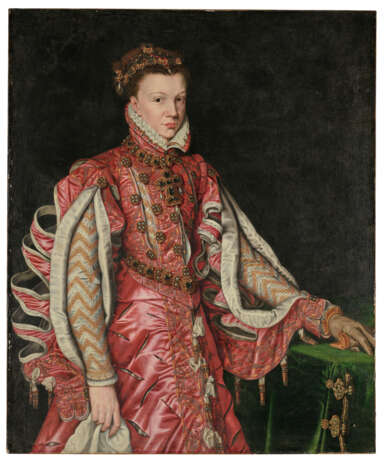ID 1336066
Lot 13 | JOORIS VAN DER STRAETEN (PAYS-BAS MÉRIDIONAUX, ACTIF ENTRE 1552 ET 1577)
Estimate value
€ 70 000 – 100 000
Portrait d'Élisabeth de Valois (1545-1568), reine consort d'Espagne, de Naples et de Sicile, dans une robe brodée parée de bijoux, de trois-quarts, à côté d'une table drapée
huile sur toile
112 x 93 cm (44 x 36 2/3 in.)
Provenance
Chez Charles Albert de Burlet (1882-1956), Bâle, avant le 17 mars 1917 ;
Vendu par celui-ci pour moitié à Kunstsalon Paul Cassirer (1871-1926), Berlin, entre le 17 mars et le 2 novembre 1917 (chacun détenant le tableau à la moitié - no. inv. 2872, comme Coello) ;
Acquis auprès de ceux-ci par W. von Stumm (probablement Wilhelm von Stumm [1869-1935]) le 2 novembre 1917.
Chez Harari & Johns, Londres (comme Anthonis Mor - selon une étiquette au revers du cadre).
Vente anonyme, Sotheby's, Londres, 27 mai 1987, lot 2 (comme d'après Anthonis Mor).
Chez Harari & Johns, Londres ;
Acquis auprès de celui-ci par l'actuel propriétaire le 10 juin 1991.
Literature
J. M. Varez, The Portraits of Elizabeth de Valois as Queen of Spain, [Master Thesis], Courtauld Institute of Art, University of London, 1990, p. 54, p. 95, notes 28 et 30, reproduit en noir et blanc fig. 28.
Further details
JOORIS VAN DER STRAETEN (ACTIVE BETWEEN 1552 AND 1577), PORTRAIT OF ELISABETH OF VALOIS (1545-1568), QUEEN CONSORT OF SPAIN, NAPLES AND SICILY, IN A JEWELED EMBROIDERED DRESS, THREE-QUARTER VIEW, NEXT TO A DRAPED TABLE, OIL ON CANVAS
This sumptuous portrait executed by Jooris van der Straeten (active 1552-1577) after the prime by Antonis Mor (1516/1521-1576) depicts the young Queen of Spain, Elisabeth de Valois (1546-1568), shortly after her marriage to Philip II of Spain (1527-1598) in 1559.
Elisa Bermejo Martinez, in her catalogue entry on Mor’s prime (E. Bermejo in S. Breuer-Hermann et al., Alonso Sánchez Coello y el Retrato en la Corte de Felipe II, [exh. cat.], Madrid, 1990, p. 131), postulates that the sitter may be shown in the clothes she wore for her wedding in Spain. Whilst this cannot be proven, in the charmingly named Mémoire de ce qu’il faut pour Madame (MS. de IMP. bo. 8638, fol. 55. Collection de Documents Inédits), Elisabeth’s trousseau is described in detail, and includes a crimson dress heavily embroidered with gold, in which description it is very tempting to see the dress in the present portrait. Given the meticulousness with which the costume is detailed, it is likely that the young Queen would have lent her jewellery and clothing to Mor, allowing him to work on this without her being present.
Daughter of Henri II of France (1519-1559) and his wife Catherine de Medici (1519-1589), Elisabeth was, like all royal women of her time, a pawn on Europe’s political chess-board. When Elisabeth was just four years old, Henri II entered into discussions with the English ambassadors to organise a marriage contract between her and the young, protestant King Edward VI of England (1537-1553). However, Edward’s death in 1553 at the age of sixteen put an end to this controversial match. It was not until 1558, with the negotiations surrounding the Treaty of Cateau-Cambrésis that a new husband was suggested for the young princess. The treaty, eventually signed in two parts in 1559, brought an end to the Eleventh Italian War, fought between France, Spain and the Holy Roman Empire for control of various territories on the Italian peninsular, most notably the Duchy of Milan. During the original negotiations, Elisabeth had been offered in marriage to Don Carlos, Prince of Asturias (1545-1568), heir to the Spanish throne. However, the death of Mary Tudor (1516-1558), second wife of Philip II, in November 1558 changed the situation. Instead the hand of the French Princess was given to the Spanish King himself as a sign of the peace between the two historically warring states. For this reason, she became known in Spain as Isabel de La Paz, Elisabeth of Peace.
From a diplomatic perspective, it would have been very important for a portrait of the new Spanish Queen to be swiftly executed and widely disseminated as the visual symbol of the new French-Spanish union. It is not surprising that Philip turned first to Antonis Mor, his court artist, for such an important commission. The Dutchman had returned to Spain in 1559, likely accompanying Philip back from the Netherlands. Van der Straeten, who may have done some of his original training with Mor, is also recorded in Spain in 1559, when he received a commission for the church of Santiago de Cáceres. That he should have been tasked with executing other versions of Elisabeth’s portrait after Mor’s departure from Spain in 1561 is therefore logical. Indeed, he went on to become one of her official painters, recorded under the name Jorge de la Rua, between 1560 and 1571, before finally leaving for France to work as a painter for another Elisabeth, Queen of France (1554-1592), wife of Charles IX of France (1550-1574), and sister-in-law to the Spanish Queen.
There are six known versions of the present portrait, Mor’s prime (that unlike the other versions is executed on panel; Várez Fisa collection, Spain), one other given to Mor himself sold at Christie’s in 1994 (8 July 1994, lot 54), one by Alonso Sánchez Coello (1531-1588), previously also in the Várez Fisa collection, and three further examples that are less easily distinguishable workshop productions. In addition to these, an extended full-length version is in a private collection in America, and there are a number of bust-length reductions, most notably that in the Louvre (inv. no. 1721/ MR 929). It is equally a portrait that has inspired other artists outside of Mor’s own circle; Sir Peter Paul Rubens (1577-1640) made a sketch of it in 1609 (see L. Burchard, Corpus Rubenianum, XXIV, fig. 168), and later Edgar Degas (1834-1917) made a delicate black chalk sketch of her head, now held in the Fitzwilliam Museum, Cambridge (inv. no. PD.22-1978).
| Artist: | Jooris van der Straeten (XVI century - 1577) |
|---|---|
| Applied technique: | Oil on canvas |
| Art style: | Old Masters |
| Genre: | Portrait |
| Place of origin: | Europe, Spain |
| Auction house category: | Paintings, Watercolors, Drawings, Paintings |
| Artist: | Jooris van der Straeten (XVI century - 1577) |
|---|---|
| Applied technique: | Oil on canvas |
| Art style: | Old Masters |
| Genre: | Portrait |
| Place of origin: | Europe, Spain |
| Auction house category: | Paintings, Watercolors, Drawings, Paintings |
| Address of auction |
CHRISTIE'S 8 King Street, St. James's SW1Y 6QT London United Kingdom | |
|---|---|---|
| Preview |
| |
| Phone | +44 (0)20 7839 9060 | |
| Buyer Premium | see on Website | |
| Conditions of purchase | Conditions of purchase |





